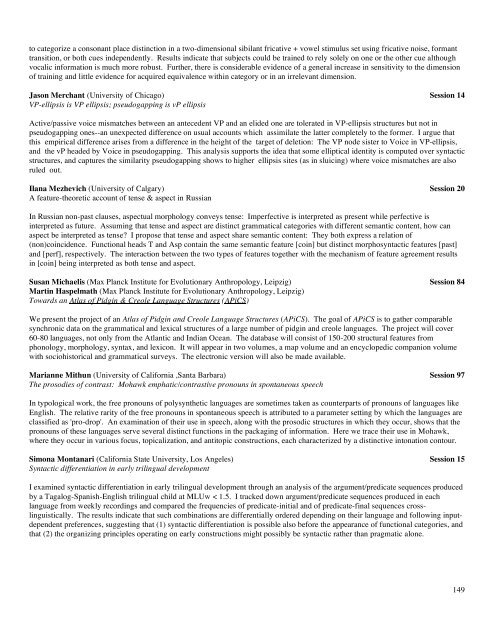View the meeting handbook - Linguistic Society of America
View the meeting handbook - Linguistic Society of America
View the meeting handbook - Linguistic Society of America
You also want an ePaper? Increase the reach of your titles
YUMPU automatically turns print PDFs into web optimized ePapers that Google loves.
to categorize a consonant place distinction in a two-dimensional sibilant fricative + vowel stimulus set using fricative noise, formanttransition, or both cues independently. Results indicate that subjects could be trained to rely solely on one or <strong>the</strong> o<strong>the</strong>r cue althoughvocalic information is much more robust. Fur<strong>the</strong>r, <strong>the</strong>re is considerable evidence <strong>of</strong> a general increase in sensitivity to <strong>the</strong> dimension<strong>of</strong> training and little evidence for acquired equivalence within category or in an irrelevant dimension.Jason Merchant (University <strong>of</strong> Chicago) Session 14VP-ellipsis is VP ellipsis; pseudogapping is vP ellipsisActive/passive voice mismatches between an antecedent VP and an elided one are tolerated in VP-ellipsis structures but not inpseudogapping ones--an unexpected difference on usual accounts which assimilate <strong>the</strong> latter completely to <strong>the</strong> former. I argue thatthis empirical difference arises from a difference in <strong>the</strong> height <strong>of</strong> <strong>the</strong> target <strong>of</strong> deletion: The VP node sister to Voice in VP-ellipsis,and <strong>the</strong> vP headed by Voice in pseudogapping. This analysis supports <strong>the</strong> idea that some elliptical identity is computed over syntacticstructures, and captures <strong>the</strong> similarity pseudogapping shows to higher ellipsis sites (as in sluicing) where voice mismatches are alsoruled out.Ilana Mezhevich (University <strong>of</strong> Calgary) Session 20A feature-<strong>the</strong>oretic account <strong>of</strong> tense & aspect in RussianIn Russian non-past clauses, aspectual morphology conveys tense: Imperfective is interpreted as present while perfective isinterpreted as future. Assuming that tense and aspect are distinct grammatical categories with different semantic content, how canaspect be interpreted as tense? I propose that tense and aspect share semantic content: They both express a relation <strong>of</strong>(non)coincidence. Functional heads T and Asp contain <strong>the</strong> same semantic feature [coin] but distinct morphosyntactic features [past]and [perf], respectively. The interaction between <strong>the</strong> two types <strong>of</strong> features toge<strong>the</strong>r with <strong>the</strong> mechanism <strong>of</strong> feature agreement resultsin [coin] being interpreted as both tense and aspect.Susan Michaelis (Max Planck Institute for Evolutionary Anthropology, Leipzig) Session 84Martin Haspelmath (Max Planck Institute for Evolutionary Anthropology, Leipzig)Towards an Atlas <strong>of</strong> Pidgin & Creole Language Structures (APiCS)We present <strong>the</strong> project <strong>of</strong> an Atlas <strong>of</strong> Pidgin and Creole Language Structures (APiCS). The goal <strong>of</strong> APiCS is to ga<strong>the</strong>r comparablesynchronic data on <strong>the</strong> grammatical and lexical structures <strong>of</strong> a large number <strong>of</strong> pidgin and creole languages. The project will cover60-80 languages, not only from <strong>the</strong> Atlantic and Indian Ocean. The database will consist <strong>of</strong> 150-200 structural features fromphonology, morphology, syntax, and lexicon. It will appear in two volumes, a map volume and an encyclopedic companion volumewith sociohistorical and grammatical surveys. The electronic version will also be made available.Marianne Mithun (University <strong>of</strong> California ,Santa Barbara) Session 97The prosodies <strong>of</strong> contrast: Mohawk emphatic/contrastive pronouns in spontaneous speechIn typological work, <strong>the</strong> free pronouns <strong>of</strong> polysyn<strong>the</strong>tic languages are sometimes taken as counterparts <strong>of</strong> pronouns <strong>of</strong> languages likeEnglish. The relative rarity <strong>of</strong> <strong>the</strong> free pronouns in spontaneous speech is attributed to a parameter setting by which <strong>the</strong> languages areclassified as 'pro-drop'. An examination <strong>of</strong> <strong>the</strong>ir use in speech, along with <strong>the</strong> prosodic structures in which <strong>the</strong>y occur, shows that <strong>the</strong>pronouns <strong>of</strong> <strong>the</strong>se languages serve several distinct functions in <strong>the</strong> packaging <strong>of</strong> information. Here we trace <strong>the</strong>ir use in Mohawk,where <strong>the</strong>y occur in various focus, topicalization, and antitopic constructions, each characterized by a distinctive intonation contour.Simona Montanari (California State University, Los Angeles) Session 15Syntactic differentiation in early trilingual developmentI examined syntactic differentiation in early trilingual development through an analysis <strong>of</strong> <strong>the</strong> argument/predicate sequences producedby a Tagalog-Spanish-English trilingual child at MLUw < 1.5. I tracked down argument/predicate sequences produced in eachlanguage from weekly recordings and compared <strong>the</strong> frequencies <strong>of</strong> predicate-initial and <strong>of</strong> predicate-final sequences crosslinguistically.The results indicate that such combinations are differentially ordered depending on <strong>the</strong>ir language and following inputdependentpreferences, suggesting that (1) syntactic differentiation is possible also before <strong>the</strong> appearance <strong>of</strong> functional categories, andthat (2) <strong>the</strong> organizing principles operating on early constructions might possibly be syntactic ra<strong>the</strong>r than pragmatic alone.149
















